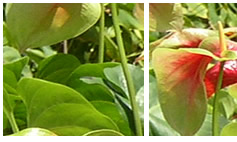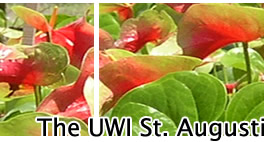 |
 |
||||
 |
 |
 |
|||
|
|
Pest & Diseases of Anthurium in the Caribbean Anthracnose | Bacterial blight | Bacterial leaf spot | Bacterial wilt | Nematode decline | Leaf cutting ants | Snails and slugs Anthracnose Anthracnose is caused by the fungus Colletotrichum gloeosporioides. It is of minor significance to the anthurium industry in the Caribbean. However, if left uncontrolled, this disease could cause significant cut-flower loss. Symptoms start as tiny brownish spots on the flower spadix. During high humidity these spots enlarge, appear water-soaked and turn necrotic. Sometimes the entire spadix will turn black as lesions coalesce. The shape of most lesions is, however, angular due to the shape of the spadix tissue. As the disease becomes more severe, masses of orange coloured spores form on necrotic areas. Leaves and spathes are rarely if ever infected. Bacterial blight disease caused by Xanthomonas campestris pv. dieffenbachiae (= Xanthomonas axonopodis pv. dieffenbachiae) affects a broad range of ornamental and edible aroids including anthurium, Colocasia (taro), Aglaonema, Syngonium, Xanthosoma, Dieffenbachia, Epipremnum, Dracaena, Alocasia, Spathiphyllum, Rhaphidophora, Caladium, and Philodendron. Bacterial blight disease of anthurium was first reported in Brazil in 1960 and Hawaii in 1971. In the humid tropics, high rainfall coupled with year-round high temperatures increases the severity and spread of bacterial blight disease making it a very important impediment to the cultivation of anthurium in the Caribbean. Global distribution and introduction of the disease in the Caribbean The disease became a major problem in Hawaii in the 1980s and caused major decline in the production of anthurium there in the 1980s. In 1982, bacterial blight disease was accidentally introduced from Venezuela to Guadeloupe, causing severe decline of anthurium grown under traditional and greenhouse methods. This decline caused significant losses to commercial anthurium growers and was identified as an important limiting factor for the development of the crop in Martinique, Guadeloupe and indeed the rest of the Caribbean. Symptomology: Foliar symptoms usually start at, or close to the leaf margins and occasionally in the centre of leaves. The first sign of infection is the appearance of irregular water-soaked spots on areas on the underside of leaves and spathes and faint chlorosis when viewed from the upper side. As infection proceeds, the spots become brown or black at the centre and bright yellow at the edges. Bacterial blight damage spreads quickly and will eventually cover large sections of the leaf or spathe. Infections often become systemic as the bacteria enter the vascular system of the plant. A characteristic symptom of advanced systemic infection is discoloration of the vascular system. In most cases, systemic infection leads to plant death. Effects of the disease: Foliar bacterial blight disease can severely decrease farm productivity, and hence the profitability of anthurium cultivation. Infected leaves are removed, sometimes to a bare stem to reduce further disease spread. The reduced photosynthetic capacity as a result of leaf removal causes plant stunting. In cases where most of the leaves have been removed, flowers are not produced at all, plants take longer to mature or are unmarketable, being either deformed or small. Control measures: Bacterial blight is a contagious disease that is difficult to control. The pathogen spreads by excessive water splashing (rain or irrigation), movement of infected soil, and contact with infected plant material, tools (from leaf pruning, harvesting) and persons walking through infected plants. The bacterial blight pathogen could survive for many months in tissue-cultured plantlets without showing any symptoms. Furthermore, the pathogen can survive in leaf lamina, petiole, and root residues for as long as four months when tissues are left on the ground or buried 15 cm deep; the pathogen retains its pathogenicity during that time.
Where the disease has been already established, sanitation practices should be performed. These include: Cutivar resistance: The most effective control measure for bacterial blight disease is the use of resistant cultivars. The use of such cultivars will reduce the cost and risk associated with anthurium cultivation. A rapid screening method for determining resistance to the disease at both the foliar and systemic phases have been developed at the University of the West Indies, which for the first time provides a practical means of identifying resistance to bacterial blight. With this two-stage screening method several anthurium cultivars with resistance/ high tolerance to the disease combined with good horticultural attributes have been developed. The method is now being routinely used on a commercial farm in Trinidad with great success. |
© 2004 - The University of The West Indies. All rights reserved. Disclaimer | Privacy Statement Telephone: (868) 662-2002 Fax: (868) 663-9684 |
|